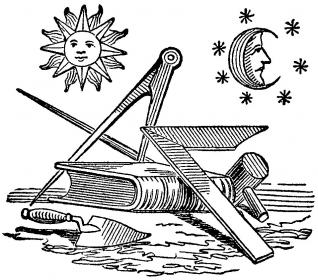Well, as it turned out, I’m still
alive; I’ve not been assassinated in some mysterious accident. So, I can still
continue with this article I started last week. You might think I’m being too
paranoid, but that’s what happens when we find ourselves in a world where
knowing too much can get you hurt. Last week, I started an article trying to
give some answers to some questions that are being asked over time; questions
on ‘the Illuminati Order’, ‘Freemasonry’ and ‘the New World Order’. From the article last week, I started with the Illuminati Order. This week, I will
be focusing more on Freemasonry,
with a little touch of the Illuminati
Order.
 Freemasonry is a fraternal organisation that arose from obscure origins in the late 16th to early 17th
century. The origins and early development of Freemasonry are a matter of some
debate and conjecture. Freemasonry now exists in various forms all over the
world, with a membership estimated at around six million. The fraternity of Freemasonry, also known as "Free and Accepted Masons,"
is organized by private groups of members variously known in English as lodges,
chapters, councils, commanderies, consistories, etc., which can be collectively
referred to as Masonic bodies. Grand Lodges and Grand Orients are independent and
sovereign bodies that govern Masonry in a given country, state, or geographical
area (termed a jurisdiction). There is no single overarching governing body that presides
over worldwide Freemasonry; connections between different jurisdictions depend
solely on mutual recognition.
Freemasonry is a fraternal organisation that arose from obscure origins in the late 16th to early 17th
century. The origins and early development of Freemasonry are a matter of some
debate and conjecture. Freemasonry now exists in various forms all over the
world, with a membership estimated at around six million. The fraternity of Freemasonry, also known as "Free and Accepted Masons,"
is organized by private groups of members variously known in English as lodges,
chapters, councils, commanderies, consistories, etc., which can be collectively
referred to as Masonic bodies. Grand Lodges and Grand Orients are independent and
sovereign bodies that govern Masonry in a given country, state, or geographical
area (termed a jurisdiction). There is no single overarching governing body that presides
over worldwide Freemasonry; connections between different jurisdictions depend
solely on mutual recognition.A Lodge must hold regular meetings at a fixed place and published dates. It will elect, initiate and promote its members and officers; it will build up and manage its property and assets, including its minutes and records; and it may own, occupy or share its premises. Like any organisation, it will have formal business to manage its meetings and proceedings, annual general meetings and committees, charity funds, correspondence and reports, membership and subscriptions, accounts and tax returns, special events and catering, and so forth.
 The Freemasons began as members of
craft guilds who united into lodges in England in the early 1700's. They
stressed religious tolerance, the equality of their male peers, and the themes
of classic liberalism and the Enlightenment. Today they are a worldwide
fraternal order that still educates its members about philosophical ideas, and
engages in harmless rituals, but also offers networking for business and
political leaders, and carries out charitable activities. The idea of a
widespread freemason conspiracy originated in the late 1700's and flourished in
the US in the 1800's. Persons who embrace this theory often point to purported Masonic
symbols such as the pyramid and the eye on the back of the dollar bill as evidence of the conspiracy.
The Freemasons began as members of
craft guilds who united into lodges in England in the early 1700's. They
stressed religious tolerance, the equality of their male peers, and the themes
of classic liberalism and the Enlightenment. Today they are a worldwide
fraternal order that still educates its members about philosophical ideas, and
engages in harmless rituals, but also offers networking for business and
political leaders, and carries out charitable activities. The idea of a
widespread freemason conspiracy originated in the late 1700's and flourished in
the US in the 1800's. Persons who embrace this theory often point to purported Masonic
symbols such as the pyramid and the eye on the back of the dollar bill as evidence of the conspiracy.While Freemasonry has often been called a "secret society," Freemasons themselves argue that it is more correct to say that it is an esoteric society, in that certain aspects are private. The most common phrasing is that Freemasonry has, in the 21st century, become less a secret society and more of a “society with secrets.” The private aspects of modern Freemasonry are the modes of recognition amongst members and particular elements within the ritual. Despite the organisation's great diversity, Freemasonry's central preoccupations remain charitable work within a local or wider community, moral uprightness (in most cases requiring a belief in a supreme being) as well as the development and maintenance of fraternal friendship, as James Anderson's Constitutions originally urged amongst brethren.
Ritual,
symbolism, and morality
 Masons conduct their
meetings using a ritualised format. There is no single Masonic ritual, and each
jurisdiction is free to set (or not set) its own ritual. However, there are
similarities that exist among jurisdictions. For example, all Masonic ritual
makes use of the architectural symbolism of the tools of the medieval operative stonemason. Freemasons, as speculative masons (meaning philosophical building
rather than actual building), use this symbolism to teach moral and ethical
lessons of the principles of "Brotherly
Love, Relief, and Truth;"
Masons conduct their
meetings using a ritualised format. There is no single Masonic ritual, and each
jurisdiction is free to set (or not set) its own ritual. However, there are
similarities that exist among jurisdictions. For example, all Masonic ritual
makes use of the architectural symbolism of the tools of the medieval operative stonemason. Freemasons, as speculative masons (meaning philosophical building
rather than actual building), use this symbolism to teach moral and ethical
lessons of the principles of "Brotherly
Love, Relief, and Truth;" or as related in France, "Liberty, Equality, and Fraternity." Two of the principal symbolic tools always found in a Lodge are the square and compasses.
Freemasonry explicitly and openly states that it is neither a religion nor a substitute for one. In fact, Regular Freemasonry requires that its candidates believe in a Supreme Being, but the interpretation of this term is subject to the conscience of the candidate. It should be noted that Freemasonry is a non-religious and non-political organisation, and discussion of politics and religion are forbidden at lodge meetings. Also, the Illuminati symbol commonly referred to as the All Seeing Eye, is said to be a reminder of a higher being. A supreme being!
The Illuminati - Freemason Conspiracy
 The
idea of a widespread freemason conspiracy originated in the late 1700's and
flourished in the US in the 1800's. Persons who embrace this theory often point
to purported Masonic symbols such as the pyramid and the eye on the back of the one
dollar bill as evidence of the conspiracy. Weishaupt (the founder of the
Illuminati Order) began planning a group to challenge authoritarian Catholic
actions in 1775; the group (under a different name) was announced on May 1,
1776. This group evolved into the Illuminati. The Enlightenment rationalist
ideas of the Illuminati were, in fact, brought into Masonic lodges where they
played a role in a factional fight against occultist philosophy. The Illuminati
was suppressed in a series of edicts between 1784 and 1787, and Weishaupt himself
was banished in 1785.
The
idea of a widespread freemason conspiracy originated in the late 1700's and
flourished in the US in the 1800's. Persons who embrace this theory often point
to purported Masonic symbols such as the pyramid and the eye on the back of the one
dollar bill as evidence of the conspiracy. Weishaupt (the founder of the
Illuminati Order) began planning a group to challenge authoritarian Catholic
actions in 1775; the group (under a different name) was announced on May 1,
1776. This group evolved into the Illuminati. The Enlightenment rationalist
ideas of the Illuminati were, in fact, brought into Masonic lodges where they
played a role in a factional fight against occultist philosophy. The Illuminati
was suppressed in a series of edicts between 1784 and 1787, and Weishaupt himself
was banished in 1785.It is well established that by the end of the eighteenth century, the Illuminati had been effectively disbanded. Because of Freemasonry's inadvertent involvement and the misuse of Freemasonry by the Illuminati's founder, Weishaupt, who had become a Mason, the legends of its continued existence (and influence) persist into the twenty-first century tying the organizations somehow together. In fact, Weishaupt founded the organization and then tried to get the Freemasons involved. He achieved a very limited success in a couple of lodges but was soon seen as a 'user' and his group removed - not unlike the 'fake Masonry' of today, actually! Perhaps some of the confusion regarding the organization is due to the fact that over time, the word Illuminati came to be used more expansively for many enthusiasts of Enlightenment. Nevertheless, the Illuminati's connection with Freemasonry was date-specific (the late 1700s) and place-specific (what is now Germany); it had NO involvement in Freemasonry elsewhere despite fanciful claims.



















0 comments:
Post a Comment